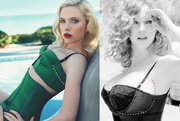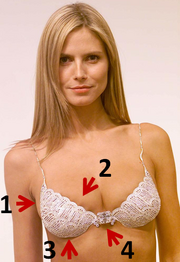| Line 37: | Line 37: | ||
If breasts spill over the [[Bra anatomy#Cup|cups]] either on the tops or out the sides (like into the armpit area), the cup is too small. Go up a cup size. |
If breasts spill over the [[Bra anatomy#Cup|cups]] either on the tops or out the sides (like into the armpit area), the cup is too small. Go up a cup size. |
||
| − | In some cases |
+ | In some cases quadboob can be caused by cups not suited to your shape. Many plunges are too closed and cut in, this is called plunge-related quadboob. Some breasts are too soft for plunges and halfcup, women who have these kind of breasts will always get quadboob in plunges and halfcups despite them being the right size or even too big. |
| + | |||
| + | Women with a shallow shape and or with a lot of upper pole fullness will have problems with cups that are too closed for them, on them bras in the right size might cut in. Halfcups are a good solution to that. |
||
| + | |||
| + | Also quadboob can be caused by a too tight band. The band pulls the cup flat, the rim of the cup cuts in and causes quadboob, despite the cup being the right size or even too big. Insert an extender into the bra band and see if it gets better. |
||
===Tight band=== |
===Tight band=== |
||
Revision as of 06:58, 8 January 2013

With close-set breasts (left), breast tissue begins farther from the armpit, and a larger band is needed so that the cup can better reach the breast tissue. Compare to the woman on the right's breasts, which begin closer to the armpit. As she is wearing a too-small cup and a too-large band, the cup doesn't fully enclose her breast tissue.[1]
Bra troubleshooting is how to easily solve common problems with incorrect bra fit. Remember that the cup and band are not independent; cup volume changes if you change only the band size. If you are trying to correct for band size alone, not cup volume, then you need to make an adjustment to both elements at once. For example, if you're wearing a 34H and you feel the band doesn't fit well, your next stop should be a 32HH not a 32H (unless, of course, you're attempting to diagnose a poor band and cup fit at the same time).
A change in cup volume can be done by changing band size alone, but this is tricky, as it alters both variables at once. It is best to first find proper band size, then work off that to find cup size. Most importantly, a bra should be comfortable and flattering. Even if it meets all the requirements, such as breasts contained in cups, flush band, and comfortable shoulder straps, if it makes your boobs pointier than you'd like, gives them a weird shape, or otherwise affects your confidence, try another bra. You might find that changing the bra style gives you a better fit; depending on your breast shape, some cup shapes may fit better than others.
Common issues
Asymmetrical breasts
If one cup fits well and the other is either too small or large, there is a difference of breast size. Ideally, choose a bra to suit the larger breast. With smaller cups, stretch fabric cups can help, but these bras usually do not provide enough support on larger breasts. Molded and lightly padded cups can also help to disguise the difference. Straps can also be adjusted individually for each breast. Shorten the straps on the smaller and lengthen them on the larger. If needed, some bras are sold with removable padding; try wearing such a bra with the padding removed from the larger breast. Often a lumpectomy as part of breast cancer treatment leaves patients with uneven breasts, there are specialised silicone pads manufactured by Amoena and Anita to accomodate this. A specialist dealing with breast cancer patients might be best equipped to help you find the perfect silicone pad for your smaller breast. [2] Always fit the bra to the larger breast.
Back band riding up
If the band rides up in the back (i.e. curves towards your neck, not parallel with the floor), the band size is too big. Go down a band size.
Cups too wide on the sides
If the cup does not perfectly enclose your breast tissue on the sides and reached over too far, you may have close-set breasts or breasts with narrow roots. Pick a brand that is known for making narrow wires, and/or increase band size until the cup starts at the root of the breast.[1]
Gore does not tack
If the gore doesn't tack (touch your torso), the cup size is most likely too small. Go up a cup size.
There is also a chance that the cups are simply too shallow for your breasts. Look into your breast shape and try to find a bra recommended for it.[3]
Another possible explanation for a gore that doesn't tack is a band that is too tight. The too tight band pulls the cup flat and the gore lifts up, despite the cup being the right size or even too big. In some cases the gore does not tack bc the wires in use are too soft to support the weight of the breasts. This is a frequent issue in Freya and Fantasie past UK H-cup.
Painful straps
If the straps painfully dig into your shoulders, loosen the straps to a two-finger tightness. If your breasts sag when you do so, then you were using the straps to over-support them. Your band should do most of the work supporting your breasts, not the straps. Check the length of the band and if necessary, go down in band size. Another possible explanation is that the cups you have been wearing are too large. Check the size of the cups and consider going down in cupsize.
Painful band
If the band feels painfully tight, try the bra on with the cups in the back and the closure in the front. A too small cup can make the band feel tight. Trying the bra on with the cups in the back will tell you whether the length of the band is right or not. The band should be snug enough to support the weight of your boobs.
If you have a relatively fatless ribcage (either mostly skin or mostly muscle) and the band feels too tight and underwires seem to be painfully "clacking" against your ribs, the band is too small. Go up a band size.[1] If the wires move and rub however, the band might actually be too wide. If this is an already purchased, non-returnable bra that you are trying to make work, a bra liner may be used to provide protective padding. Alternatively, you could use a bra extender.
Painful underwire
If underwire is digging into your sides/armpits or isn't flush against your sternum, the cup size too small. Go up in cup size until the wires are wide enough. In addition try a brand known for having wide wires.
Quad-boob
If breasts spill over the cups either on the tops or out the sides (like into the armpit area), the cup is too small. Go up a cup size.
In some cases quadboob can be caused by cups not suited to your shape. Many plunges are too closed and cut in, this is called plunge-related quadboob. Some breasts are too soft for plunges and halfcup, women who have these kind of breasts will always get quadboob in plunges and halfcups despite them being the right size or even too big.
Women with a shallow shape and or with a lot of upper pole fullness will have problems with cups that are too closed for them, on them bras in the right size might cut in. Halfcups are a good solution to that.
Also quadboob can be caused by a too tight band. The band pulls the cup flat, the rim of the cup cuts in and causes quadboob, despite the cup being the right size or even too big. Insert an extender into the bra band and see if it gets better.
Tight band
If the band is too tight, the band size is too small. However, the cups being too small can also make the band feel too tight. Go up a band size, but only if you are sure that the cup size is not the problem.

This model suffers from a multitude of common bra fit problems:
1. Breasts spill over the sides.
2. Breasts overflow the cups.
3. Breasts pop out of the underside.
4. The gore is not flush against her ribcage.[4]
Underbust irritation
If experiencing rashes, redness, or soreness on the underside of the breast, then the cup is likely too small. Increase cup size until the underwire rests in the breast crease instead of on top of the breast, separating the breast from the skin on the ribcage. Wear a bra with a bottom band, and cups with a supportive panel design. A soft cup wireless bra may also be considered. Finally, if this is an already purchased, non-returnable bra that you are trying to "make work," a bra liner may be used to provide protective padding.
Underbust spilling
If the bottom of the cups rest on your breasts instead of your torso (also seen when the center gore does not rest against your chest), then the cup size is too small; go down a band size or up a cup size, possibly even both at the same time.
Underwire pops out
If the underwire frequently pops out the bra, the band is too large or the wire has been overly distressed, usually by a too small cup. Go up in cup size, and if necessary down in bandsize. Never wash bras in hot water or put them in a tumble dryer. In addition stretch the underwire casing after washing it when it is still wet, it has a tendency to shrink even when handwashing it.
Wrinkly cups
If the bra cup is wrinkly, either the cup is too big or the style of the cup isn't suited to your breast shape (i.e. the cup is shaped to compliment a woman with upper pole fullness and you have more volume in the bottom). Go down a cup size or try a different cup shape.
Wrinkles in a starburst-pattern around your nipples indicate a too small cup. Usually this is caused by wires that are too narrow for your breasts, but this kind of wrinkling can also appear in wireless bras. Go up in cupsize if this occurs.
References
- ↑ 1.0 1.1 1.2 The Butterfly Collection: "The Women Who Need to Add Inches to their Bra Band"
- ↑ Her Room: "Practical Solutions to Bra Fitting Problems"
- ↑ [http://publishwith.me/8qtcuKDr4l Public Pad: "Bra Fitting Problems and Possble Explanations"
- ↑ Swimwearandlingerie: "Bra fitting problems of the Victoria’s Secret models"